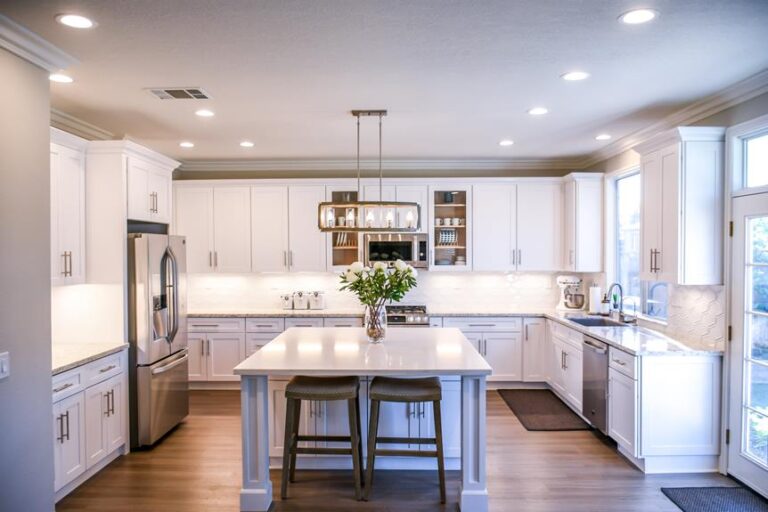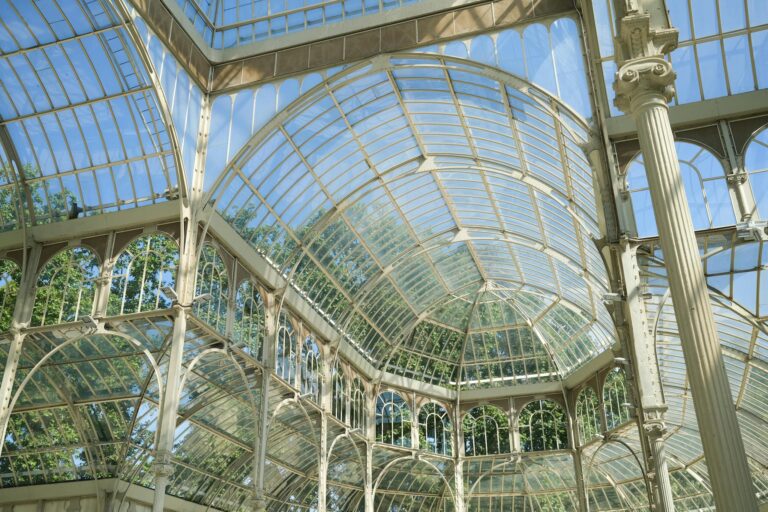DIY Conservatory Plans
Embarking on a DIY conservatory project presents an intriguing opportunity for homeowners to not only enhance their living space but also to engage directly with the design and construction process. The endeavour requires meticulous planning, from selecting the right materials to understanding the legalities involved.
Yet, the satisfaction derived from crafting a personalised extension of one’s home cannot be understated. As we explore the intricate steps of building a DIY conservatory, from initial planning to the final touches, one must consider if the benefits of customisation and cost savings outweigh the challenges that lie ahead.
Key Takeaways
- DIY conservatory plans offer homeowners cost-effective ways to expand living space.
- Adequate planning and compliance with building regulations ensure legal and safe construction.
- Customisable design options allow for seamless integration with existing home aesthetics.
- Utilises DIY lean-to and wooden conservatory plans for quick and personalised construction.
Introduction to DIY Conservatory Building
Embarking on the construction of a DIY conservatory offers homeowners the opportunity to tailor their additional living spaces to their specific requirements and aesthetic preferences, thereby enhancing the functionality and appeal of their homes.
This process, detailed through comprehensive DIY conservatory plans, encompasses a series of structured steps from inception to completion, ensuring a streamlined and effective construction journey.
Moreover, the endeavour not only presents a cost-efficient approach to home expansion but also significantly elevates the property’s value through the addition of a bespoke and versatile conservatory.
Benefits of Building Your Own Conservatory
Constructing your own conservatory offers unparalleled flexibility in design, allowing for a personalised space that perfectly aligns with your preferences and requirements.
Utilising DIY conservatory plans, including DIY lean to conservatory plans and DIY wooden conservatory plans, enables quick construction, potentially within four days, providing a cost-effective method to enhance your home’s size and value.
This fully customisable process allows for significant control over the project’s budget.
Overview of the Building Process
Initiating the process of building a DIY conservatory involves meticulous planning and precise execution, starting from the foundation to the final touches.
By utilising conservatory plans online or a conservatory DIY plan, homeowners can navigate the construction sequence efficiently—from planning to foundation installation, frame assembly, roof installation, and final touches.
These conservatory DIY plans ensure a quick, efficient build, potentially enhancing your home’s value and space with a personal touch.
Planning Your DIY Conservatory
In the progression of constructing a DIY conservatory, selecting the appropriate design plans is a critical step that demands thorough consideration. This phase involves evaluating various factors such as compliance with local planning permission, alignment with property aesthetics, and the functional requirements of the conservatory.
It is imperative to meticulously assess these elements to ensure the chosen plans meet both regulatory standards and personal preferences.
Choosing the Right DIY Plans
Selecting the appropriate DIY conservatory plans requires a careful consideration of your property’s dimensions, intended use, and geographical orientation to ensure a harmonious and functional addition to your home. Factor in local building regulations and planning permission requirements, and research different roof types—glass, polycarbonate, or tiled—to match your climate and aesthetic preferences.
This meticulous approach promotes a sense of belonging and ensures a well-integrated conservatory that enhances your living space.
Foundations and Initial Setup
The foundational phase of constructing a DIY conservatory is critical, beginning with the implementation of a ConservaBase system for streamlined installation.
This stage encompasses the integration of floor insulation to optimise thermal efficiency within the structure.
Additionally, the process involves the installation of fully-welded sections and the secure attachment of fixing skirts, ensuring a robust base setup while employing protective measures to safeguard the floor integrity throughout the installation.
Constructing the Foundation
Laying a solid foundation for a DIY conservatory begins with the preparation and installation of the ConservaBase system, ensuring a stable and energy-efficient base. Essential steps include:
- Integrating floor insulation to boost energy efficiency.
- Positioning fully-welded sections for a robust framework.
- Attaching the skirt to fortify the base’s perimeter.
- Safeguarding the floor to preserve the foundation’s integrity during installation.
Installing the ConservaBase System
Initiating the ConservaBase system installation marks a pivotal step in establishing a durable and energy-efficient foundation for your DIY conservatory.
Day 1 focuses on setting a stable base, involving foundation construction, floor insulation, and the assembly of fully-welded sections. Skirt fixing and wall section installation are integral.
Adhering to detailed guidelines for foundation and floor protection ensures the success of your conservatory project.
Assembling the Conservatory Structure
Moving forwards from the foundational setup, the next critical phase in constructing a DIY conservatory involves the precise assembly of the structural components. This phase encompasses the meticulous installation of the frame, followed by the careful placement and securing of the roof and glazing materials to ensure structural integrity and weather resistance.
Detailed video tutorials provide invaluable guidance throughout this process, ensuring that each step is executed with precision for optimal results.
Frame Installation Steps
Assembling the conservatory’s frame requires careful adherence to step-by-step instructions to ensure accurate alignment and maintain the stability of the structure.
- Secure the base to create a solid foundation for the construction process.
- Fit and connect frame components with precision, ensuring that each piece fits together correctly.
- Pay careful attention to the structural strength of the assembly.
- A meticulous frame assembly helps to avoid future problems and establishes the groundwork for the entire construction.
Roof and Glazing Installation
After ensuring the frame is securely installed, the next critical phase in constructing a conservatory involves the precise installation of the roof and glazing, pivotal for the structure’s weather resistance and thermal performance.
Fitting the roof structure onto the conservatory walls and installing glass panels with meticulous alignment and sealing are essential.
Adhering to manufacturer’s guidelines ensures the conservatory’s structural integrity and thermal efficiency, reinforcing a sense of belonging among DIY enthusiasts.
Cost Considerations for DIY Conservatories
In the context of DIY conservatory plans, understanding and managing the financial aspects of the project is paramount.
It is essential to evaluate the potential savings, which can amount to up to 75% when compared to conventional installation methods, alongside the transparent pricing structures that delineate cost differences and affordable options.
This approach not only facilitates informed decision-making but also ensures a balance between customisation and control over the project’s total expenditure.
Budgeting for Your Project
When embarking on the construction of a DIY conservatory, it is imperative to meticulously plan your budget. This planning should encompass the cost of the conservatory kit, which may vary from £2,000 to £10,000. Additionally, budgeting should factor in other expenditures such as tools, foundation materials, glazing options, and any necessary professional assistance.
- Conservatory kit: £2,000 – £10,000
- Tools and foundation materials
- Glazing options
- Professional assistance
Customising Your Conservatory Design
Within the realm of DIY conservatory construction, a critical aspect to consider is the customisation of your conservatory design to suit your unique requirements and preferences.
Options for lean-to conservatories present a versatile and efficient choice for homeowners seeking to maximise their space while ensuring a seamless aesthetic integration with the existing property structure.
This section will explore the various customisation options available for lean-to conservatories, emphasising the importance of selecting the appropriate materials, colour schemes, and additional features to enhance both functionality and visual appeal.
Options for Lean-to Conservatories
Customisation stands as a key advantage of Lean-to conservatories, offering homeowners a spectrum of options to tailor spaces to their unique preferences and home’s architectural style.
- Varying roof pitches to match existing structures.
- Customisable sizes for perfect space optimisation.
- A selection of glazing choices for energy efficiency and aesthetics.
- Adaptability to different architectural styles, ensuring seamless integration with modern homes.
Overcoming Common DIY Challenges
In the construction of DIY conservatories, troubleshooting installation issues is imperative for ensuring structural integrity and long-term functionality.
This encompasses addressing challenges in foundation accuracy, frame alignment, and effective sealing techniques to mitigate future complications.
Troubleshooting Installation Issues
Embarking on a DIY conservatory project often involves navigating a plethora of installation challenges, from foundational support discrepancies to intricate glazing intricacies.
- Ensure base installation is level and adequately supported.
- Address frame assembly issues, such as misalignment or missing components.
- Resolve roof installation problems, including leaks and improper sealing.
- Overcome glazing difficulties by ensuring proper fit and insulation to prevent breakage.
Finishing Touches and Decorations
Upon completing the structural aspects of a DIY conservatory, the focus shifts to interior design ideas that enhance both aesthetics and functionality.
Careful selection of lighting fixtures, furniture, and decorative elements is crucial in creating an inviting and practical space.
Through the strategic incorporation of plants, personalised decor, and complementary furnishings, one can achieve a conservatory that seamlessly blends comfort with style.
Interior Design Ideas
To elevate the aesthetic appeal and functionality of a DIY conservatory, it is imperative to thoughtfully select and arrange interior design elements, such as cosy seating, decorative accessories, and ambient lighting.
- Integrate comfortable seating options such as sofas or armchairs.
- Enhance warmth with decorative cushions, throws, and rugs.
- Incorporate nature with potted plants or hanging planters.
- Install soft lighting fixtures to create a serene ambiance.
Legal and Safety Considerations
As we progress with our DIY Conservatory Plans, it is imperative to address the significance of adhering to building regulations. These regulations serve as a framework to ensure not only the structural integrity of the conservatory but also the safety of its occupants. Compliance with these standards is a critical step in the planning and execution stages of construction, necessitating thorough understanding and application to avoid legal complications and ensure a durable build
Adhering to Building Regulations
Ensuring compliance with Building Regulations is crucial for DIY conservatory projects to meet legal and safety standards. Key considerations include:
- Structural stability to withstand environmental pressures.
- Energy efficiency to minimise heat loss.
- Adequate ventilation for a comfortable living environment.
- Adherence to local guidelines to avoid legal repercussions.
Failure to comply can lead to significant consequences, including fines or the need for demolition, underscoring the importance of thorough planning and execution.
Conclusion
Considering the substantial cost savings, versatility in design, and the enhancement of living space, DIY conservatories represent a practical and financially astute choice for homeowners looking to expand their property.
With potential savings up to 75%, rapid assembly, extensive customisation, and comprehensive support, these conservatories are a valuable addition, fostering a sense of belonging while significantly increasing both the functionality and market value of a home.
Frequently Asked Questions
Can I Build a Conservatory Myself?
Yes, with basic DIY skills and the necessary tools, individuals can construct a conservatory themselves. Utilising detailed instructions and technical support provided with kits, homeowners can achieve significant cost savings and personalised customisation through self-assembly.
What is the Cheapest Way to Build a Conservatory?
The most cost-effective method to construct a conservatory involves utilising DIY conservatory kits. These kits offer significant savings, transparent pricing, and allow homeowners to manage the project, effectively reducing the overall financial investment required.
How difficult is it to build a conservatory?
Constructing a conservatory can be manageable for those with DIY enthusiasm. Utilising self-assembly kits, which include detailed instructions, and requiring basic tools, the process is designed to be accessible, offering a rewarding project outcome.
How much does it cost to build a conservatory?
The cost of constructing a conservatory varies widely, typically ranging between £3,000 and £15,000. This variation is attributed to factors such as size, design, materials, and added features, influencing the overall expenditure.






